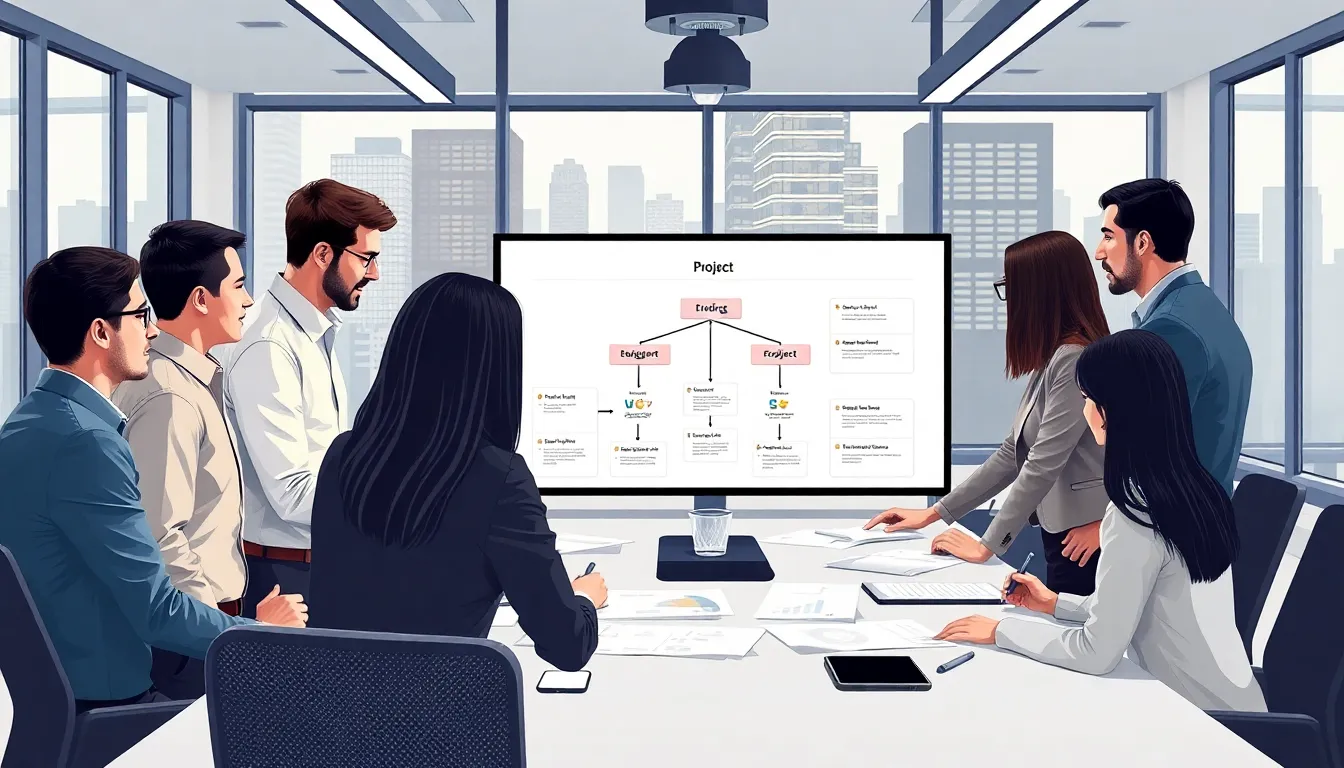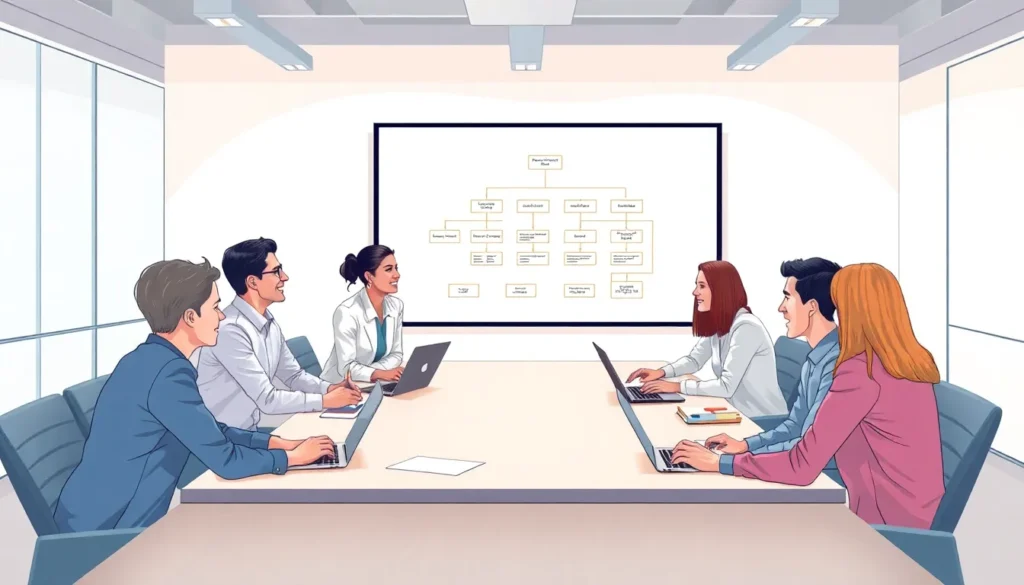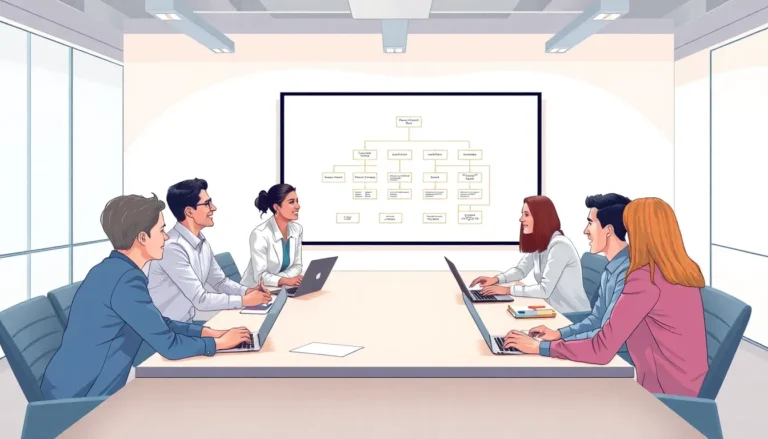Table of Contents
ToggleIn the chaotic world of project management, organization isn’t just a nice-to-have—it’s a must-have. Imagine trying to find a needle in a haystack while blindfolded. That’s what unorganized projects feel like. By mastering project organization, teams can transform chaos into clarity, turning frantic flailing into focused finesse.
Whether it’s juggling deadlines, coordinating team efforts, or keeping track of resources, a well-organized project can be the difference between a triumphant launch and a spectacular flop. So grab your favorite planner and get ready to dive into the art of project organization. It’s time to turn that messy desk into a streamlined success story, all while keeping a smile on your face. After all, who said organization can’t be fun?
Understanding Project Organization
Project organization involves structuring a project to enhance efficiency and effectiveness. It requires clarity in roles, processes, and communication.
Definition of Project Organization
Project organization defines the arrangement of tasks, resources, and responsibilities within a project. This structure establishes how team members interact and coordinate their efforts. Specific roles, such as project manager and team leads, ensure accountability. Effective project organization includes the use of tools and systems to manage timelines, budgets, and personnel. A well-defined project organization chart outlines relationships and reporting lines, promoting transparency and facilitating decision-making.
Importance of Project Organization
Project organization plays a crucial role in achieving successful project outcomes. Organized projects enable teams to meet deadlines consistently. Clarity in roles and responsibilities reduces confusion, allowing team members to focus on their tasks. Effective organization also aids resource management, ensuring that materials and personnel are utilized efficiently. By improving communication, project organization fosters collaboration among team members, leading to innovative solutions. Ultimately, a well-organized project minimizes risks and enhances stakeholder satisfaction.
Key Elements of Project Organization

Project organization encompasses various components that contribute to successful project management. Understanding these elements fosters clarity and efficiency among team members.
Roles and Responsibilities
Clear roles and responsibilities are fundamental in project organization. Each team member, from project manager to team leads, has specific tasks to fulfill. Assigning these roles ensures accountability across the project. Project managers oversee the project’s progress and make strategic decisions. Team leads coordinate their specific areas, providing guidance while addressing team needs. Involving all members in defining roles fosters ownership of tasks. An organized structure minimizes confusion, streamlining communication and enhancing collaboration.
Project Structure
An effective project structure lays the foundation for an organized approach. This structure defines the hierarchy and delineates interdependencies among tasks. Task breakdowns facilitate the clear assignment of duties and deadlines. A visual project organization chart aids team members in understanding their position within the project. Establishing phases or milestones allows for manageable progress tracking. The project structure must adapt to changes, maintaining flexibility while ensuring alignment with project goals. Projects with well-defined structures inherently meet deadlines and achieve outcomes efficiently.
Best Practices for Effective Project Organization
Effective project organization relies heavily on clear communication and the right tools. Teams achieve clarity with open lines of dialogue and consistent updates.
Clear Communication
Communication channels must be established and maintained throughout the project. Regular meetings help team members share progress, address concerns, and refine goals. Additionally, using collaborative platforms for messaging and file sharing fosters transparency. Each member should know their responsibilities because defined roles enhance accountability. Documenting discussions ensures that everyone is aligned with the project objectives. Establishing guidelines for communication, like frequency and methods, streamlines information exchange.
Utilizing Project Management Tools
Project management tools significantly enhance organizational efficiency by centralizing tasks and resources. Software options like Trello, Asana, or Microsoft Project allow teams to visualize project progress. These platforms provide functionalities such as task assignment, deadline tracking, and progress reporting. Automatic notifications alert team members about upcoming deadlines and changes, keeping everyone informed. Integrating these tools with other applications can further streamline workflows. Emphasizing usage of such tools enables teams to manage their workload and improves collaboration.
Challenges in Project Organization
Project organization faces several challenges that can impede progress and efficiency. Identifying these issues allows teams to develop effective solutions.
Common Pitfalls
Disorganization leads to confusion among team members. Miscommunication often occurs when roles are unclear, causing delays in task completion. Overlapping responsibilities create friction and waste resources. Adapting to frequent changes in project scope can also derail planning and execution. Team members may struggle to track milestones, leading to missed deadlines. Lastly, a lack of proper tools can hinder visibility into project status, reducing overall effectiveness.
Strategies to Overcome Challenges
Establishing clear roles enhances accountability among team members. Implementing regular status meetings ensures everyone is aligned on objectives. Using project management tools like Trello or Asana centralizes tasks and improves communication. Setting realistic deadlines helps manage expectations and resource allocation. Visual organization charts can simplify understanding of project structure. Encouraging open channels for feedback fosters a culture of transparency and collaboration.
Conclusion
Embracing project organization is essential for any team aiming for success. A structured approach not only clarifies roles and responsibilities but also enhances communication and collaboration. By implementing best practices and utilizing effective tools, teams can navigate challenges with ease and maintain focus on their objectives.
The benefits of an organized project extend beyond meeting deadlines; it fosters a culture of accountability and innovation. As teams adapt to changes and streamline their processes, they position themselves for greater achievements. Ultimately, investing in project organization transforms chaos into clarity, paving the way for successful outcomes and satisfied stakeholders.







